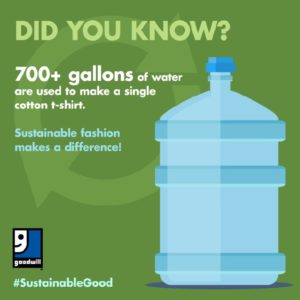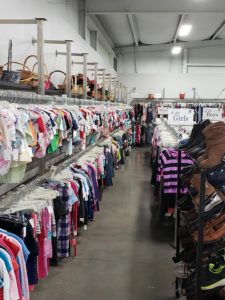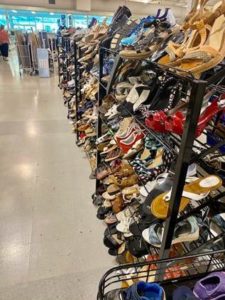Goodwill: Where Sustainability Meets Fashion!
Here are a few facts that may surprise you: the average person buys 60% more clothing items per year than they did in the year 2000 but keeps each garment only half as long. Those discarded items of clothing can sit in landfills for up to 200 years! That’s a long time, especially considering the resources it takes to make a single item of clothing these days. It can take more than 700 gallons of water to produce the cotton needed to make just one t-shirt!

Make a difference with Goodwill!
The fact is that clothing production isn’t what it used to be. In the not-so-distant past, clothing took significantly longer to make. Clothes were produced using high-quality materials that lasted decades, not months. The cycle of buying and discarding clothing quickly is actually fairly new. It’s a result of what’s called the ” fast fashion” industry.
What is fast fashion?
” Fast fashion” refers to clothing that’s produced very quickly, usually to keep up with the latest trends. Fast fashion clothing is often made with inexpensive materials and sold in stores at very low prices. While this may sound like a benefit to consumers, there are some significant drawbacks to fast fashion.
The problem with fast fashion
Although the price tags on fast fashion clothing items may be low, the costs to our planet are high. Fast fashion is usually made using low-quality, non-biodegradable materials. Because the clothing is not made to last, it’s often discarded within a few months. Fast fashion clothing that ends up in landfills can take decades to break down fully, harming the environment in the process. The constantly-changing trends and affordable prices contribute to a seemingly endless cycle of consumers buying clothes, discarding them, and then buying more in order to have the latest styles.
How can you slow down the effects of fast fashion?
Thankfully, there are many easy, affordable ways to fight against fast fashion and make a difference! Here’s what you can do:
Shop secondhand. One of the best ways to reverse the negative impacts of fast fashion is to shop at thrift stores like Goodwill. Buying brand-new clothing increases the demand for fast fashion, whereas thrift shopping extends the life cycle of perfectly good items. Shopping secondhand is also highly affordable, helping you get more for your money. In a thrift store like Goodwill, you can find on-trend designer clothing and accessories as well as rare vintage and retro pieces to express your unique style!

Clothing racks at Goodwill Oxford Store

Shoe rack at Ohio Valley Goodwill Store
Take good care of your clothes. Increasing the longevity of your clothing will help you save money on replacing damaged pieces. Plus, it will make your clothing more desirable if you decide to donate it. Taking care of your clothes is as simple as learning to fold and hang them properly, repairing tears and replacing missing buttons, and washing and treating stains correctly.
Donate your unwanted items. When you no longer want or need articles of clothing and accessories, donate them to Goodwill. Someone else is sure to love repurposing your gently-used pieces! If your donations don’t sell, Goodwill works with recycling partners to ensure donated clothing and other textiles are recycled responsibly.

Tidy up and donate to Goodwill!
Sustainable fashion made simple
Ohio Valley Goodwill is your headquarters for sustainable style! As original advocates of the reduce, reuse, recycle movement, Goodwill has made sustainability an integral part of our mission. Every day, we help extend the life cycle of clothing and other reusable goods through our innovative donate-resale model.
By donating to Goodwill and shopping in our stores, you’re not only helping the planet””you’re helping your community. Your support makes it possible for Ohio Valley Goodwill to provide valuable job skills programs and employment services for individuals with disabilities and veterans. It’s all a part of our commitment to change lives through the power of work!
Find your nearest Ohio Valley Goodwill donation center or retail store today. Thank you for being a job creator!



